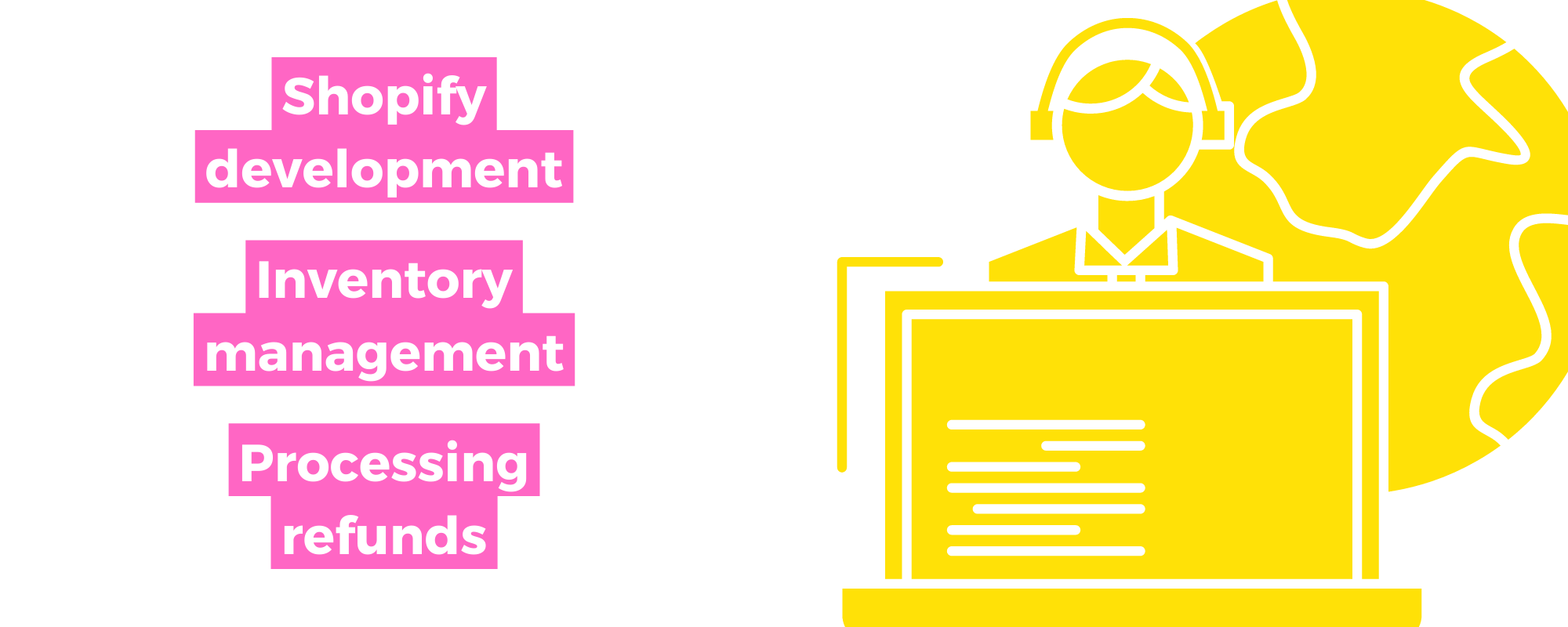
Top Tips on Growing Your Ecommerce Business With Shopify
CATEGORIES
Tags
24/7 analytics australia automation Business Process Outsourcing company Copywriting CRM customer support data data and analytics Delegate digital digital advertising digital marketing Digital Support Staff ecommerce Email Management Email Marketing Entrepreneur Freelance Writers google ads graphic design Hiring Freelancers Marketing offshore offshoring ominchannel support organizer outsource Outsourcing Philippines Project management reporting seo seo audit Shopify Small Business social media Social media experts social media management United States video Virtual Assistant Virtual Team
If you want a successful online business growth needs to be at the top of your list. Increase your revenue and attract more customers by applying the following techniques proven to help you grow your ecommerce business with Shopify.
1. Market Research

You cannot afford to conduct market research slowly. While you’re dilly-dallying, your competitors will be implementing changes to their brand. If businesses want to learn insightful things about their customers and their industry, they need to conduct correct, up-to-the-minute research.
Whether you already have something in the pipeline or you’re still thinking of what to sell, always study your market.
Market research improves your branding. Are your customers aware of your brand? The best thing about it is you can see how your customers perceive your brand. And see how you compare to your competitors. With good market research you can easily pinpoint how to adjust and improve your product offering.
2. Marketing, marketing, marketing

Successful companies have one thing in common, they have high standards in marketing.
You don’t always have to spend a fortune, though you do want to hire specialists to give you the biggest bang for buck. You can take advantage of low-cost marketing strategies for promoting your Shopify store:
- Email Marketing: A cost-efficient marketing strategy to build a positive relationship with your existing customers. You can offer them discounts and promotions as an added value for people who send their email to you. Shopify’s Email Marketing Feature
- Influencer Marketing: Find your niche influencers. Someone to promote your products to their audience. Popular applications like Facebook, Instagram, TikTok, and YouTube have a lot of reputable influencers with negotiable prices.
What makes your business different from your competitors? Do you stand out, how would you explain the differences in less than 10 words. Once you have those ten words, build your marketing around those core pillars.
It’s worthwhile to investigate marketing strategies that have been tried and proven effective by other Shopify accounts. You could also spend money on Shopify marketing features and apps that operate in tandem with your online store to gather customer data and increase sales.
3. Taking advantage of social media

Social media is where everything is at your fingertips. The first thing you need to do when you have a social media account is to build an active and engaged community with high-quality content. Think quality, not quantity. You’re better having 2, 3, 5 active followers than 1,000 that never comment or engage with your page.
Create a space for your existing customers and interested buyers to socialize. Provide them with quality images, videos, posts, and drop discounts and promotions on special seasons. Stay responsive when your customer posts.
When social media becomes too much to manage, outsource it. Find the right social manager, who understands ecommerce, to leverage the work you have done so far.
4. Investing in customer service

Happy customers spend more. It’s proven that positive customer service can increase your sales, repurchases, and customer loyalty. It is worth investing in customer-facing responsibilities to help your business in the long run.
You can also gain insights directly from your customers. What do they complain about the most? You’ll see what you lack when you have another set of eyes to judge it for you.
5. Improve ranking in organic product listing

Customers who search on the Shopify shopping tab are highly motivated to make a purchase. Thus your product listing there may perform better in terms of conversion than the standard search engines. Below are some tips to improve your Shopify product listing:
- Make sure your high quality photos have a well-written product description: Bulleted points are more readable than blocks of paragraphs and walls of text. If your DIY product description is not efficient, you can hire competent freelance writers to help you.
- Don’t tell, communicate: Product descriptions are a way for people to know more about your product. Make sure you have a good copy that can motivate people to purchase your product. You can add product benefits and suggestions.
- Link your product to other options: If your Shopify store offers a similar item with different variants, link it. Give them options. Or link an item complementary- tables with lamps, tops and pants. Make them stay longer in your store and add more to their carts.
- Reviews are your lifeline: 90% of people trust user-generated contents over advertisements. To get a good review, make sure your product quality, customer service, experience, and after purchase services are good and positive.
Only approved products appear in Shopping tab search results. For related product searches, your products might also show up as a rich snippet in the search results page. After setting up your Shopify account and connecting it to Google Merchant Center, the Google channel will automatically sync your products and other relevant information about your store.
If you already use the Google channel to sync your products with Google Merchant Center, you can verify that Surfaces across Google has accepted your product feed. Your products may appear in Google Surfaces’ unpaid product listings.
6. Optimize for every screen

Mobile devices account for a sizable majority of the 7.1 billion average monthly browsing sessions on Shopify and 66% of orders placed on Shopify merchants’ online stores. This means optimizing your product image to provide the same user experience on different devices.

What is the right dimension?
To make the zoom function work for your image, its resolution must be higher than 800×800 pixels. You can upload up to 4472 x 4472 pixels up to 20mb in Shopify but their website encourages square photos with 2048 x 2048 pixels. This is to make it have a professional and well-rounded look.
What is the right format?
There are tons of picture formats to try but they have different effects in your Shopify store. Below are some of the commonly used formats and how you can utilize them.
- JPG: Easier to compress with good color range. Shopify recommends JPG because of its small size.
- PNG: Keeps the image quality even when compressed. It can also support transparency which makes product presentation appear professional. But it is not universally as acceptable as JPG.
- GIF: The only format which can support animation and clips. It is also acceptable across browsers.
What is the perfect size for mobiles?
Shopify automatically resizes your product image to fit smaller screens by gently cropping excess in the image. Make sure your product image has square dimensions and is properly centered to avoid cropping.
Avoid slow page loading speeds. Not only will it impact your SEO, your customers will simply click away before they reach your product page. Keep your image resolution within 2048 x 2048 recommended pixels.
7. Anticipate questions

If you’re a startup or a small business without a 24/7 team to work for your customer service, then you should have a Frequently Asked Questions knowledgebase. And it won’t just help your business answer question while unavailable, below are some of the reasons why you should have FAQ across your Shopify store, websites, and social media:
- Answer purchases concerns which are not addressed in the product page.
- Enhance site navigation and SEO. You can utilize FAQ by incorporating it with keywords.
- Gain credibility by showcasing product knowledge.
- Proactively avoid negative feedback and customer complaints.
- Reduce the number of messages and calls by publicly answering frequently asked questions.
- Increase client satisfaction by providing a thoughtful response to their inquiries.
Like how a teacher writes something down after the students ask the same questions over and over again, an FAQ saves you the trouble of answering questions, and it reduces the chances of your customer going elsewhere to find their answer.
8. Personalization in every customer journey

Personalization changes the way businesses attract and retain their customers. 71% of customers expect personalization from the brands and companies they purchase from.
When a brand invests in the customer relationship, they are rewarded with brand loyalty and years of repurchase. McKinsey & Company report that when done right, personalization can directly influence the customers buying behavior. McKinsey’s study shows:
- 76% of customers are more likely to consider buying from a brand that personalizes.
- 78% of customers repurchase from a brand that personalizes.
- 78% of customers are more likely to recommend a product from a brand that personalizes.
Outsource your Shopify ecommerce tasks

Outsourcing to third-party service providers offshore saves you the burden of hiring and training experts when you need one, and they manage your existing systems efficiently, helping you avoid unnecessary costs.
All the above tips can be maximized through outsourcing. Specialists in offshore locations like the Philippines can help with your market research, marketing and every aspect of customer service.
The following are the tasks you can easily outsource to service providers like Usource:
Shopify development: Services providers can help start your shop easier. From setting up your Shopify to optimizing it for mobile, developing chatbot, web-design development, maintaining Shopify store, upgrading your existing store, and extending it services.
Inventory management: Service providers have advanced resources to get your inventory right. Service providers can help you avoid overstocking and running out.
Processing refunds: Almost 30% of ecommerce products are returned and for a customer to buy again from a product after this negative experience, you have to make things easier. By outsourcing refund processing, you can focus on your core business while prioritizing customer loyalty.
Everything ecommerce can be outsourced.
From product development to customer service, everything can be outsourced to third party service providers. Especially when you have a small team to focus on your core business, you need to scale on busy seasons, or you want an expert to help you on a specific task.
90% of Shopify stores fail to grow their business. If you’re struggling, want help to grow or just need extra support – without having to go around the block – speak to us. We can provide you with a single ecommerce team member, right through to an end-to-end ecommerce solution for your business.


